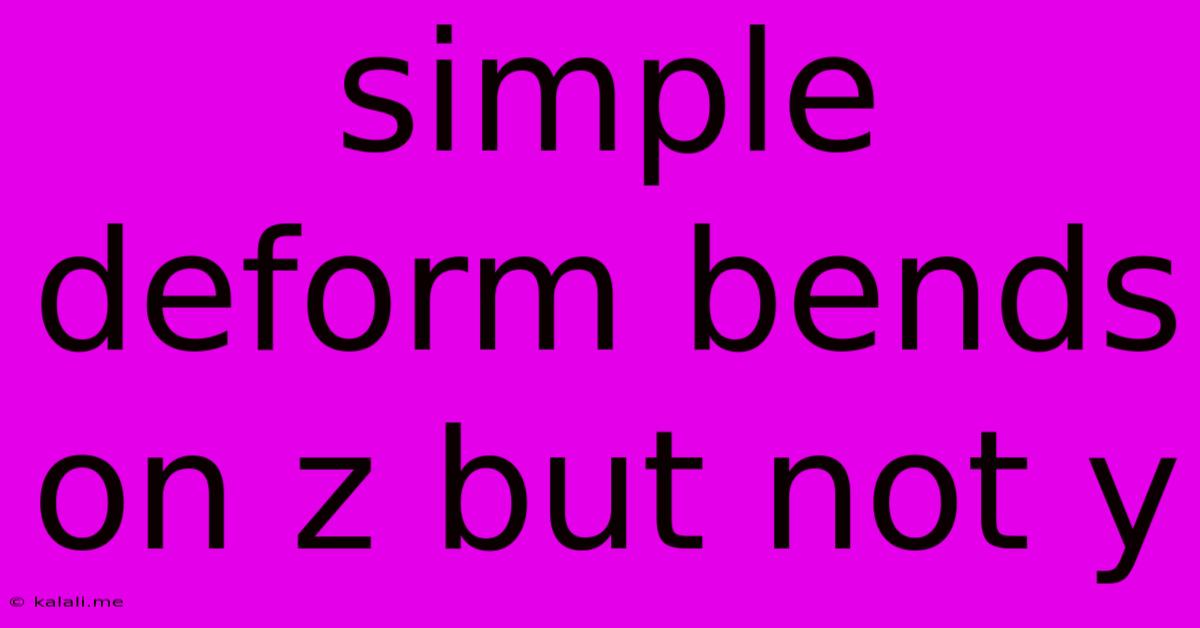Simple Deform Bends On Z But Not Y
Kalali
May 24, 2025 · 4 min read

Table of Contents
Simple Deform Bends on Z but Not Y: Troubleshooting and Solutions
This article addresses a common problem in 3D modeling and animation: why a deform bend modifier (or similar tool) only affects the Z-axis and not the Y-axis. We'll explore the potential causes and offer effective solutions to get your models bending correctly in all desired axes. Understanding the underlying principles of object orientation and modifier application is crucial for mastering this technique.
Understanding the Problem: When applying a bend modifier, expecting a curve along the Y-axis but only seeing deformation along the Z-axis, the issue typically stems from the object's orientation or the modifier's settings. This isn't a bug; rather, it's a misunderstanding of how the modifier interacts with your object's local coordinate system. The bend modifier, by default, bends around the object's local Z-axis.
Possible Causes and Solutions:
1. Object Orientation: The Root Cause
The most likely reason is the incorrect orientation of your object. The bend modifier uses the object's local coordinate system, not the world coordinate system. If your object isn't aligned correctly, the bend will occur along the wrong axis.
- Solution: Before applying the bend modifier, carefully rotate your object in the viewport using the Rotate tool (usually R key). Ensure that the axis you want to bend around (in this case, the Y-axis) aligns with the local Y-axis. You can use the gizmo to help with precise alignment. Examine the object's orientation in the Properties panel (often found under the "Object" tab) to verify its rotation values.
2. Incorrect Modifier Settings: Double-Check the Axis
While less common, the bend modifier's settings might inadvertently be targeting the wrong axis. Though most tools default to the Z-axis, there's always a possibility of accidental changes.
- Solution: Open the properties of your bend modifier. Look for settings related to the bend axis. It is usually denoted by either "Axis" or a similar term. Ensure this is set to the Y-axis explicitly, and not the Z-axis. Some applications allow direct selection from the viewport using the axis gizmo, allowing for visual confirmation and selection.
3. Conflicting Modifiers or Constraints: The Stack Order Matters
If you have multiple modifiers affecting the same object, they might be interfering with each other. The order in which modifiers are applied significantly impacts their effect.
- Solution: Examine the modifier stack. Try adjusting the order of your modifiers. Move the bend modifier higher or lower in the stack to see if it resolves the conflict. Sometimes a modifier applied after the bend might be overriding the bend's effect.
4. Pivot Point Issues: Unexpected Centers of Rotation
The pivot point dictates the center of rotation for transformations and modifiers. An incorrectly positioned pivot point could lead to unexpected bending behavior.
- Solution: Check your object's pivot point. In most 3D applications, you can easily adjust the pivot point to be at the object's origin or any other desired location. Experiment with different pivot point locations to see if that affects the bend's behavior.
5. Model Topology: Unexpected Behavior with Complex Meshes
Complex mesh topologies sometimes exhibit unpredictable behavior with deformers. Poorly modeled or overly complex meshes can cause deformations to not behave as expected.
- Solution: If your model has unusual topology, consider simplifying it. This might involve cleaning up the mesh, reducing the polygon count, or re-modeling parts to ensure consistent flow. A cleaner model will generally respond better to modifiers.
Debugging Steps:
-
Isolate the Problem: Apply the bend modifier to a simple, cleanly modeled cube to rule out mesh-related issues. This helps determine if the problem lies with the object or with the modifier settings.
-
Check the Axis: Pay close attention to which axis your bend modifier is targeting, both in the modifier settings and visually in your viewport.
-
Simplify: Remove any unnecessary modifiers or constraints to see if they are interfering with the bending effect.
By systematically checking these areas, you should be able to identify the root cause of the problem and correct it, enabling your bend modifier to work correctly along the Y-axis. Remember, understanding the local coordinate system is key to mastering 3D modeling transformations.
Latest Posts
Latest Posts
-
How Do You Get Gasoline Smell Off Your Hands
May 24, 2025
-
How To Refresh Chunks In Minecraft
May 24, 2025
-
Moves That Cant Be Used At All
May 24, 2025
-
How Do You Say Fuck In Spanish
May 24, 2025
-
Why Harry Doesnt Know That Norman Is Green Goblin
May 24, 2025
Related Post
Thank you for visiting our website which covers about Simple Deform Bends On Z But Not Y . We hope the information provided has been useful to you. Feel free to contact us if you have any questions or need further assistance. See you next time and don't miss to bookmark.